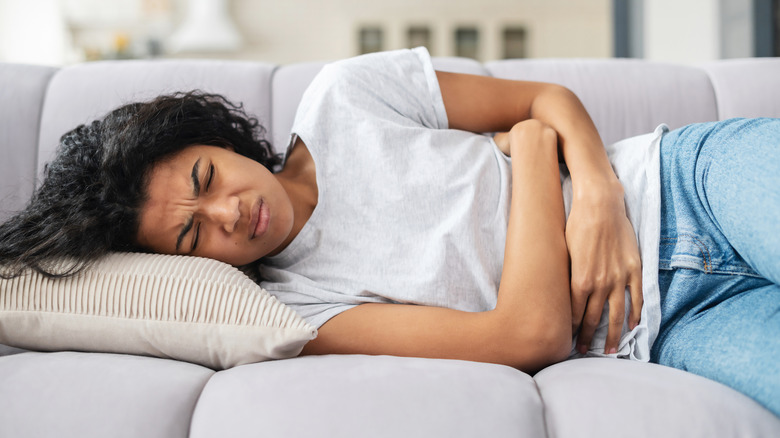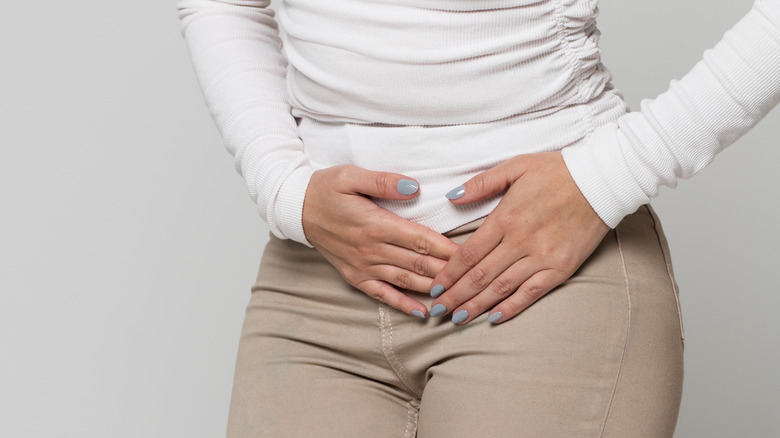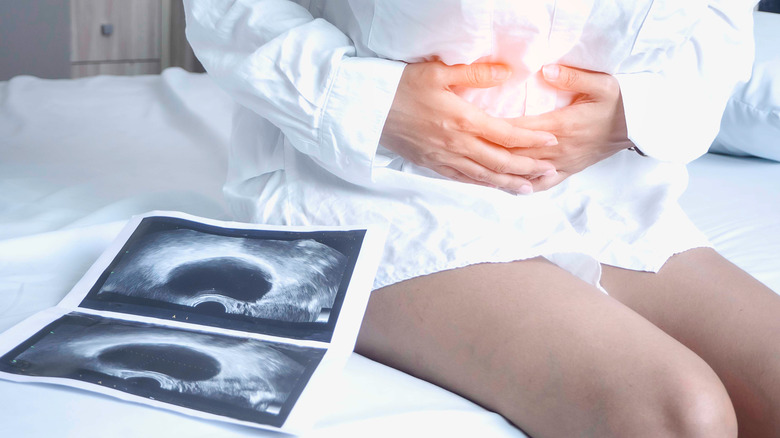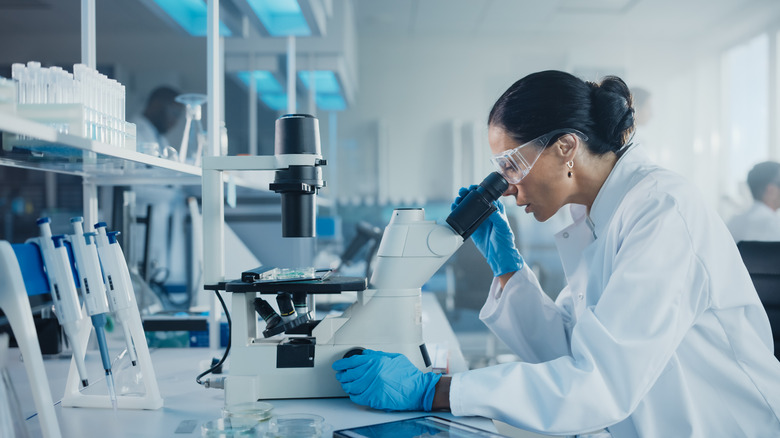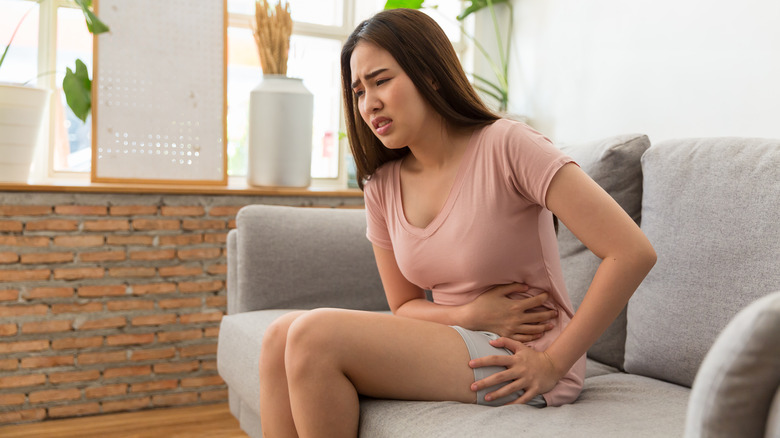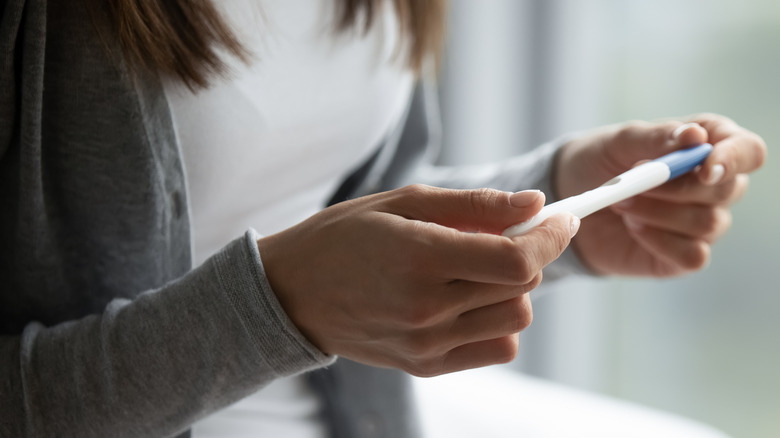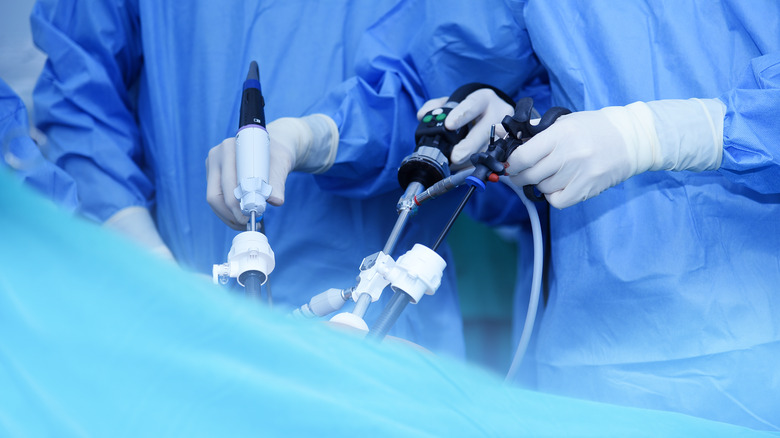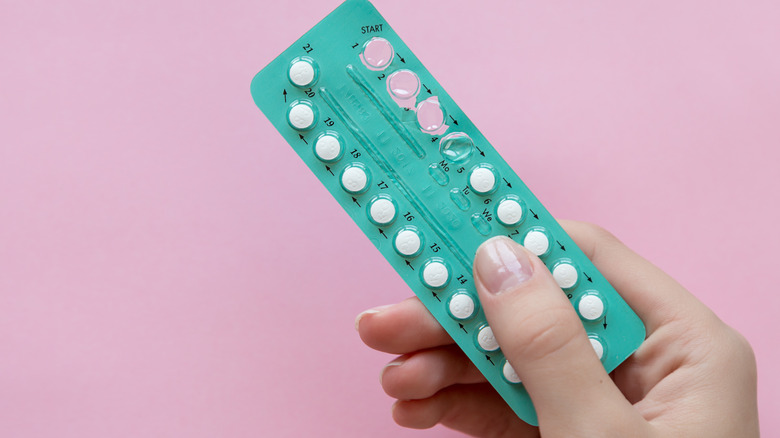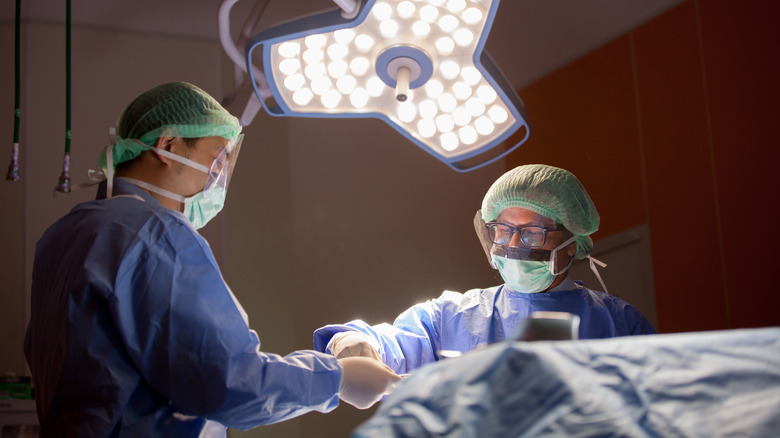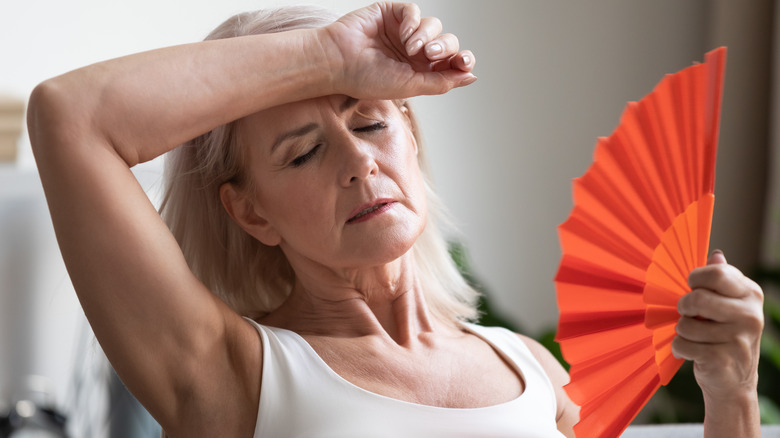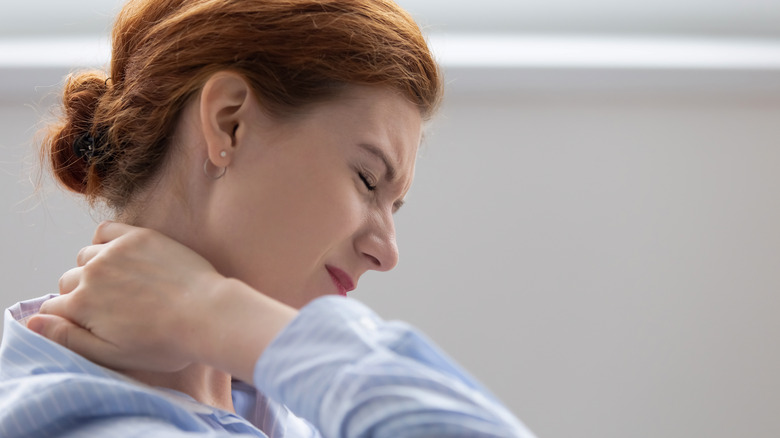Endometriosis Explained: Causes, Symptoms, And Treatments
Endometriosis is defined as a condition in which tissue that is typically within the uterus is found outside of the organ, usually in other parts of the reproductive system or the pelvis (via Mayo Clinic). This tissue goes through changes every month but although it "thickens" and "breaks down," it is stuck inside of the body, the Mayo Clinic detailed. The inflammation of this tissue can cause scar tissue to form, known as adhesions, which then cause organs to adhere to each other. As you can imagine, the pain from endometriosis can be excruciating. Johns Hopkins asserts that endometriosis affects an estimated 2 to 10% of American women between the ages of 25 and 40.
WebMD defines the three forms of endometriosis. The first kind, superficial peritoneal lesion, forms in the lining of the pelvic cavity. Endometriomas are blood-filled cysts that form in the ovaries. Unfortunately, these lesions, also called "chocolate cysts," are not easily treated. Lastly, deeply infiltrating endometriosis grows beneath the lining of the pelvic cavity and can migrate to nearby organs, such as the bowels or bladder. This type of endometriosis is rare, making up 1 to 5% of endometriosis cases (via WebMD).
The symptoms can seem normal at first
Many women experience heavy and painful periods and might not think much of the symptoms of endometriosis at first. Pain during intercourse, pain while urinating or passing bowel movements, and gastrointestinal symptoms such as diarrhea, constipation, or nausea that occur during menstruation are all symptoms of endometriosis (via Johns Hopkins).
Interestingly, the World Health Organization points out that there is "little correlation between the extent of endometrial lesions and severity or duration of symptoms." Furthermore, areas in the brain that trigger pain receptors throughout the body become extraordinarily sensitive over time, allowing women who have been successfully treated and no longer have visible lesions to still suffer from profound pain.
Women with endometriosis sometimes report feeling exhausted to the point of feeling "tranquilized," per the Endometriosis Foundation of America. This fatigue is believed to be related to the body's attempts to rid itself of the tissue that has no escape route. Cytokines secreted by the tissue that the immune system is attempting to battle can cause a great deal of inflammation and pain.
Getting a diagnosis takes a long time
Medical News Today reveals that the diagnosis of endometriosis takes an average of 6.7 years. Sadly, the average woman loses nearly 11 hours of work each week during that time due to the severe symptoms that they experience. Because endometriosis is difficult to diagnose, its symptoms are often mistaken for other conditions.
An article published in American Family Physician explains that painful sexual intercourse, a common symptom of endometriosis, can have many other causes, some as simple as issues getting aroused. "In some cases, ovarian cysts are caused by an underlying condition, such as endometriosis," the UK's National Health System explained. Nevertheless, endometriosis is not always the cause.
Diagnosis can also be hindered because a large percentage of women with endometriosis also have other health problems with similar presentations, including fibromyalgia, autoimmune disorders, and chronic fatigue syndrome, a study in the Physical Therapy and Rehabilitation Journal revealed.
Suspected causes
Retrograde menstruation has long been discussed in medical circles as a potential cause of endometriosis (via Healthline). This theory is based on the hypothesis that menstrual blood flows back through the fallopian tubes and into the pelvic cavity. According to Verywell Health, conditions that change the position of the uterus or impede menstrual flow, such as polyps, increase the risk of retrograde menstruation.
Alternatively, some experts believe that hormonal imbalances cause cells outside of the uterus to transform into endometrial cells. It has also been proposed that endometrial cells are whisked out of the uterus and carried to other parts of the body by the lymphatic system, or that endometriosis is due to a damaged immune system unable to destroy and rid the body of misplaced endometrial cells as it should. Some women associate development of endometriosis with previous surgery, such as cesarean delivery, when it is possible that menstrual blood migrated out of the uterus and infiltrated the pelvic cavity (via Healthline).
The risk factors are common
Your risk for endometriosis is higher if you started your period at a young age, have a short cycle, get heavy periods that last more than a week at a time, or have a close family member with the condition. Previous pregnancy, regular exercise, and periods that started late in adolescence are factors known to decrease risk (via Medline Plus).
Breastfeeding and eating more fruit, especially citrus, may decrease the risk of endometriosis (via NIH). The Office on Women's Health further recommends limiting both alcohol and caffeine to no more than one drink a day to avoid the increase in estrogen levels that both substances cause. They state that sodas and green tea seem to be especially troublesome for women at risk for endometriosis.
A low body mass index (BMI) is a key risk factor for the development of endometriosis. An analysis of nearly a dozen clinical trials found that risk of endometriosis was 31% lower in women with a BMI over 40 compared to women of normal weight (via Verywell Health).
Risks of endometriosis
The American College of Obstetricians and Gynecologists reveals that about 40% of women with infertility have endometriosis. The inflammation from endometriosis can damage either sperm or eggs and impede their movement through the reproductive system. In severe forms of endometriosis, the fallopian tubes might be blocked by scar tissue. Women with endometriosis also carry an increased risk of miscarriage or premature birth, and an increased risk of certain types of cancer, particularly ovarian, according to a study in the Journal of Laboratory Physicians.
The MD Anderson Cancer Center puts the link with cancer into perspective. Even taking into account the rare types of ovarian cancer that are more common in women with endometriosis, the risk is still lower than 1%. In very few cases throughout history, endometrioma has ruptured, usually during pregnancy, necessitating emergency surgery. Again, this is exceedingly rare (via American Journal of Roentgenology).
Diagnosis typically requires a minimally invasive surgery
Endometriosis is rarely diagnosed via pelvic exam (per American Family Physician). Instead, the primary method of diagnosing endometriosis is through the use of a minimally invasive procedure known as laparoscopy, according to Medscape. During this procedure, a thin tube (called a laparoscope) with a camera attached to it is inserted through the abdomen so that the surgeon can investigate the problem without having to perform open surgery, according to MedlinePlus. Biopsies of uterine tissue are taken as they are required to diagnose endometriosis (via Medscape).
Furthermore, laboratory studies to rule out infection, determine the amount of blood loss, and rule out sexually transmitted diseases will likely be carried out. Women seeking help for symptoms of endometriosis can also expect to undergo imaging studies, including ultrasonography and magnetic resonance imaging (MRI), although the AFP points out that imaging is not able to discern the "extent of endometriosis."
Pain medication and hormone therapy might help
Nonsteroidal anti-inflammatory drugs (NSAIDs) are often called upon to treat the pain of endometriosis. However, these drugs do not are only useful for symptom relief and do not alter the course of the disease, according to Medscape.
Instead, doctors stop the production of estrogen in a variety of ways to treat the underlying cause of endometriosis. Gonadotropin-releasing hormone analogs (GnRH analogs) stop the ovaries from producing estrogen and cause the pituitary gland to cease the release of other hormones. These hormonal changes stop menstrual periods and relieve pain and shrink endometriosis implants, which are "areas of endometrial tissue found in ectopic tissue," explained Medscape. By taking GnRH analogs along with progesterone, the symptoms of estrogen deficiency (which causes the symptoms commonly equated with menopause) can be avoided. Birth control pills containing a combination of progestin and estrogen are also sometimes used to treat endometriosis. Some women skip the inactive pills so that they never menstruate.
Recently, aromatase inhibitors have also been used to stop estrogen production within endometriosis implants, the ovaries, and the adipose tissue. Danazol (Danocrine) is yet another method used to stop ovulation and estrogen production, resulting in pain relief and shrinkage of the endometriosis implants for 80% of women. Unfortunately, up to 75% of women develop significant side effects, including weight gain and mood alterations, from this drug. Many will need to stop taking it, so it is rarely used.
Surgery can be conservative or radical
Laparoscopic surgery can be used to remove endometriosis implants, scar tissue, and endometriosis cysts on the ovaries, according to the University of Michigan Health. Endometriosis or scar tissue might be cut and removed or destroyed using a laser or electric current (aka electrocautery).
Unfortunately, Geisinger explained that pain and endometrial tissue can reappear after surgery. In fact, 21.5% of women will experience recurrence within two years, and 40 to 50% will within five years. It is believed that two-thirds of recurring cases are due to new disease while a third is a result of endometriosis that was missed during the original surgery (via The Conversation).
Rarely, removing the uterus and ovaries (hysterectomy and oophorectomy) is needed in cases of advanced endometriosis. This radical surgery causes estrogen levels to plummet and usually reduces pain symptoms. "As with all health-care decisions, a woman's choice of treatment for endometriosis will be based on her assessment of the risks and benefits," The Conversation detailed.
Easing the pain of endometriosis at home
Everyday Health notes that people with endometriosis are seven times more likely to experience insomnia. Dr. Karli Goldstein, a gynecologic surgeon, recommends taking a bath with essential oils to relax your muscles or experimenting with herbal teas, such as those with valerian root or chamomile to induce a feeling of sleepiness. Endocrine Society of Australia recommends using heat therapy to relax the uterus, increase blood flow, and ease the pain. They mention experimenting with "heat-packs, hot water bottles, heat patches or baths."
Other self-care strategies that women with endometriosis report employing include: practicing yoga and Pilates, utilizing massage and breathing techniques, asking for help from others, and making dietary changes (via BMC Women's Health). As Dr. Goldstein told Everyday Health, "You may need to eat healthier and focus more on wellness than those around you, but it's worth it in the long run — not just for endometriosis, but for your overall health too."
Alternative therapies
Curcumin, the main antioxidant in turmeric, may ease inflammation and change the properties of endometrial lesions, a 2020 study in the International Journal of Molecular Sciences revealed. However, further research is needed. Additionally, resveratrol, an anti-inflammatory compound found in grapes, wine, peanuts, soy, and berries, inhibits the synthesis of prostaglandins (compounds with hormone-like characteristics that cause pain), per a study in Molecules. Other antioxidants, including vitamins E and C and melatonin, have been shown to reduce symptoms and the progression of endometriosis in lab animals (via the Journal of Gynecology and Women's Health).
Acupuncture has been shown to reduce the pain that endometriosis causes and may reduce blood levels of CA-125, a cancer antigen associated with the disease, according to Everyday Health. Some women with endometriosis use medical marijuana or CBD, and both were reported as moderately or very effective for pelvic pain. However, women state that, overall, marijuana is more effective than CBD (via The Journal of Minimally Invasive Gynecology).
Symptoms can continue through menopause
Most women with endometriosis experience an alleviation of pain after menopause. Once the body stops producing estrogen, endometrial tissue inside and outside the uterus shrinks. However, "some women who take menopausal hormone therapy may still have symptoms of endometriosis," explained the Office of the Assistant Secretary for Health. Occasionally, postmenopausal endometriosis has developed in women with "no history of endometriosis on imaging or surgery prior to menopause," a study in Diagnostics detailed.
These menopausal women exceed the average amount of estrogen (known as the "estrogen threshold") expected during this stage of life, as a result of peripheral estrogen production, the consumption of phytoestrogens (found in many supplements intended to relieve menopausal symptoms), or through prescribed hormone replacement therapy. The good news is that endometriosis lesions in postmenopausal women are "less common, less extensive, and less active in most cases" compared to those in premenopausal women.
Endometriosis may be accompanied by depression and anxiety
Women with endometriosis understandably struggle with a lot of emotional stress, in addition to physical pain and other symptoms. This emotional stress can be related to chronic pain, issues with employment, or the cost of medical care. Additionally, the disease can take a toll on personal relationships, as revealed in an International Journal of Women's Health study.
Research shows that fertility problems are an independent risk factor for depression and anxiety and cause decreased self-esteem and sexual dysfunction for some women, per a 2020 study published in the International Journal of Environmental Research and Public Health. Some research indicates that 15% of women with endometriosis have depression and 29% experience anxiety. Additionally, pelvic pain itself, whether or not it's caused by endometriosis, may lead to depressive symptoms in women, as the study in the International Journal of Environmental Research and Public Health showed.
Other diseases are linked to endometriosis
In a study of 3,680 women surgically diagnosed with endometriosis, participants were over 100 times more likely to experience chronic fatigue syndrome ("a strong feeling of fatigue that lasts for at least six months") than the general population in the United States, according to the NIH. They were also more than twice as likely to experience fibromyalgia ("a recurrent pain in the muscles, tendons, and ligaments"). Twenty percent of the women had more than one other disease, and 31% of those with more than one disease had also been diagnosed with either fibromyalgia or chronic fatigue syndrome.
According to this research, women with endometriosis were also more likely to be diagnosed with asthma, allergies, and the skin condition eczema. Additionally, women with endometriosis were determined to be at a greater risk than other women for autoimmune diseases such as Sjogren's syndrome, systemic lupus erythematosus, rheumatoid arthritis, and multiple sclerosis. The women also experienced a seven-fold increase in being diagnosed with hypothyroidism (an underactive thyroid gland), which can be caused by the immune system erroneously recognizing the gland as foreign and subsequently attacking it.
A good medical team can make all the difference
Research shows that women with endometriosis who feel that their physicians are caring and competent fare much better. Positive experiences are associated with doctors who research and consider investigational treatment options, refer women to a specialist, and communicate effectively. Such women do best when they feel encouraged to take an active role in their healthcare and believe that their physician is their partner (via BMC Women's Health).
If you feel that your doctors lack knowledge about endometriosis, wave off your symptoms as a "normal" part of being a woman, don't communicate well, or are reluctant to refer you to a specialist, it might be time to consider changing providers. Additionally, participating in support groups and seeking information about the treatments, natural therapies, and other management options for endometriosis help women feel empowered. However, it's important not to overdo your research.
There is some evidence that too much information can lead to women feeling overwhelmed, overloaded, and anxious, especially if the information obtained conflicts with each other. Instead, participants felt validated when they recorded and monitored their symptoms to provide evidence for medical professionals, locate patterns, or predict when symptoms would be most severe (via BMC Women's Health).

